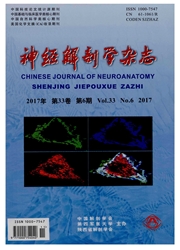

 中文摘要:
中文摘要:
为探讨大鼠发育过程中神经型一氧化氮合酶羧基末端PSD-95/DLG/ZO-1(PDZ)结合配体(carboxy-terminal PDZ ligandof nNOS,CAPON)与Dexras1 mRNA的表达及二者的相关性,本实验采用大鼠发育模型,通过实时荧光定量聚合酶链式反应(Realtime-PCR)及原位杂交组织化学(ISH)与免疫组织化学相结合的技术检测脊髓组织中CAPON及Dexras1 mRNA的表达变化。结果表明:在胚胎14~18d的脊髓组织中,CAPON mRNA呈低水平表达,生后1d表达升高并达到高峰。从形态上看,表达于尚未分化成熟的前角,随后呈逐渐下降趋势。在生后12w,表达于脊髓后角。而Dexras1 mRNA在胚胎14d呈低水平表达,16~18d时表达升高,同样在生后1d出现表达高峰并定位于尚未分化成熟的前角,随后表达逐渐下降。生后12w,在后角有表达。根据Real-time PCR结果作直线相关分析,在生后脊髓发育过程中CAPON与Dexras1 mRNA表达呈高度相关,于生后1d共定位于脊髓前角。形态学结果显示CAPON与神经型一氧化氮合酶(nNOS)表达于相同细胞,但亚细胞定位不同。本研究表明,大鼠发育过程中,脊髓组织中CAPON及Dexras1 mRNA存在共表达,提示CAPON可能通过调节nNOS,进而激活Dexras1,在神经元的分化、突触的可塑性及突触发生过程中发挥一定的作用。
 英文摘要:
英文摘要:
To study the expression of carboxy-terminal PSD-95/DLG/ZO-1 ligand of nNOS (CAPON) and Dexrasl mRNA during development in spinal cord of rat. Real-time polymerase chain reaction (PCR), as a quantitative method was used to investigate the expressive variety of CAPON and Dexrasl mRNA level in spinal cord during development. The spatial expression of CAPON and Dexrasl mRNA was examined by fluorescence in situ hybridization histochemistry. During development of spinal cord, CAPON mRNA was expressed with lower level from embryonic 14 d to 18 d. At postnatal 1 d, it reached the peak and expressed in the area which will be dorsal horn when maturation. Then CAPON mRNA decreased gradually till postnatal 12 w, when it presented in ventral horn. At embryonic 14 d, Dexrasl mRNA was expressed with lower level, consequently increased during embryonic 16 d to 18 d. Expression of Dexrasl mRNA was the same as CAPON that was confirmed by correlation analysis and immnomorphology. CAPON and nNOS expressed within the same cell of dorsal horn at postnatal 1 d but have differently subeellular localization. During development of spinal cord, the co-expression of CAPON and Dexrasl mRNA indicates that the adaptor protein, CAPON may play a properly role in differentiation of neurons, synaptic plasticity and synaptogenesis by regulating nNOS to activate Dexrasl.
 同期刊论文项目
同期刊论文项目
 同项目期刊论文
同项目期刊论文
 期刊信息
期刊信息
